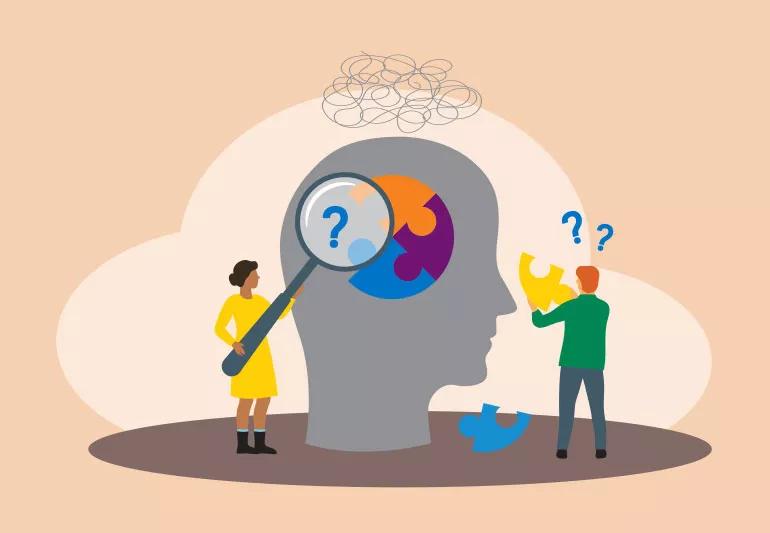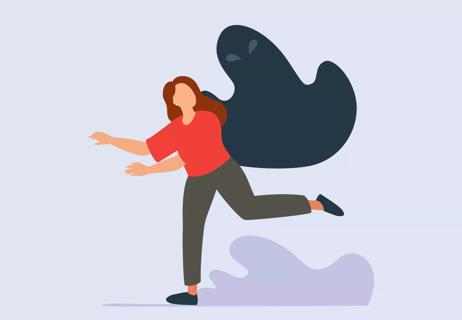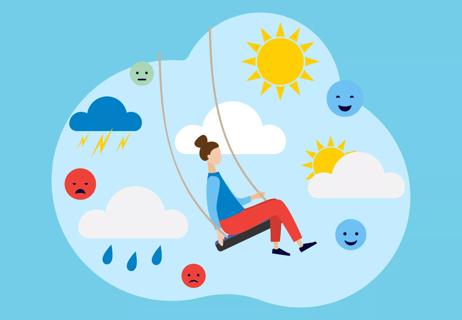People with schizoaffective disorder have additional mood symptoms

If you or a loved one has been diagnosed with — or is showing signs of — a mental illness like schizophrenia or schizoaffective disorder, you know the rollercoaster ride well.
Advertisement
Cleveland Clinic is a non-profit academic medical center. Advertising on our site helps support our mission. We do not endorse non-Cleveland Clinic products or services. Policy
The right diagnosis can be hard to reach. And when a diagnosis does come, you may be wondering what it even means.
What is schizoaffective disorder anyway? What is schizophrenia? And what does that all mean in your life?
The dividing lines between a diagnosis of schizophrenia vs. schizoaffective disorder are clearly laid out in the Diagnostic and Statistical Manual of Mental Disorders, Fifth Edition, Text Revision — DSM-5-TR, the current gold standard for the diagnosis of mental illness.
But as you probably already know, real life isn’t always as clear-cut as a reference book. The signs and symptoms of schizophrenia and schizoaffective disorder can be hard to interpret.
So, we talked with psychiatrist Travis Krew, MD, to better understand these illnesses — their similarities, their differences and, most importantly, how you can manage them to live your best life.
The difference between schizophrenia and schizoaffective disorder is this: Schizophrenia is a condition characterized by hallucinations, delusions and/or disordered thinking. People with schizoaffective disorder also have those symptoms — and, additionally, they have symptoms consistent with episodes of depression, mania or both.
Advertisement
That’s a lot to take in. So, let’s break it down.
Schizophrenia is a kind of psychosis. That means it impacts a person’s perception of reality and ability to participate in logical conversations with others. Dr. Krew explains that to be diagnosed with schizophrenia, you need to have at least one of these three main symptoms of schizophrenia and show signs of illness for six months or longer:
Additionally, people with schizophrenia may have other symptoms that can help a healthcare provider recognize the disorder. That may include things like making slow or unusual movements, isolating oneself or appearing emotionless. Those symptoms may be typical of some people with schizophrenia, but they aren’t definitive enough for a schizophrenia diagnosis on their own.
Schizophrenia symptoms often happen in stages. That means symptoms may be more severe at times and less apparent at others.
Schizoaffective disorder is one of the six types of schizophrenia.
It’s a thought disorder layered with a mood disorder. That means that in addition to having at least one of the three major symptoms of schizophrenia above, people with schizoaffective disorder also experience extreme bouts of emotional turmoil.
“I describe schizoaffective disorder as having schizophrenia, but also meeting some other criteria that modify that disorder,” Dr. Krew explains. “People with schizoaffective disorder have symptoms of depression — or depression and mania — that coincide with their symptoms of schizophrenia.”
In other words, people with schizophrenia can experience depression separately from their schizophrenia symptoms. But that’s not schizoaffective disorder.
Schizoaffective disorder is diagnosed when depression or mania are present for the majority of the time when they also experience symptoms like hallucinations, delusions and disordered thinking.
Symptoms of depression include symptoms like:
Mania is characterized by symptoms like:
| Condition | Critical symptoms | Depression symptoms | Mania symptoms |
|---|---|---|---|
| Schizophrenia | Hallucinations, delusions and/or disordered speech. | No. | No. |
| Depressive type schizoaffective disorder | Hallucinations, delusions and/or disordered speech. | Yes. | No. |
| Bipolar type schizoaffective disorder | Hallucinations, delusions and/or disordered speech. | Maybe. | Yes. |
| Condition | |||
| Schizophrenia | |||
| Critical symptoms | |||
| Hallucinations, delusions and/or disordered speech. | |||
| Depression symptoms | |||
| No. | |||
| Mania symptoms | |||
| No. | |||
| Depressive type schizoaffective disorder | |||
| Critical symptoms | |||
| Hallucinations, delusions and/or disordered speech. | |||
| Depression symptoms | |||
| Yes. | |||
| Mania symptoms | |||
| No. | |||
| Bipolar type schizoaffective disorder | |||
| Critical symptoms | |||
| Hallucinations, delusions and/or disordered speech. | |||
| Depression symptoms | |||
| Maybe. | |||
| Mania symptoms | |||
| Yes. |
Schizophrenia affects about 22 in every 1,000 people. Schizoaffective disorder is estimated to affect about 3 in every 1,000 people. But that estimate is harder to know for sure because diagnosing the disorder can be so challenging.
“It can be tricky to do the longitudinal work necessary to get the diagnosis right, particularly with schizoaffective disorder. You really need to have a good picture of the patient,” Dr. Krew explains. “There can be a haste to diagnose a person who has mood symptoms with schizoaffective disorder. Or, on the other hand, you can easily miss symptoms that would have led you to that diagnosis.”
Advertisement
Consider a person who arrives at the emergency room believing the CIA is watching them but doesn’t have proof. They also hear voices that no one else hears. Those can be clear indications of schizophrenia. So, that’s the diagnosis they’re given.
It may take a much deeper conversation to recognize that person also has a hard time getting out of bed most days (depression). Or that they recently stayed up for a few days straight repainting their entire house (mania).
Early and continuous treatment for schizophrenia and schizoaffective disorder is critical. The conditions can severely impact your physical, mental and social well-being if they aren’t properly treated.
A combination of therapy and medication is typical for people with schizophrenia or schizoaffective disorder.
Antipsychotic medication can help improve symptoms of schizophrenia. People with schizoaffective disorder will typically also take antidepressant medication or mood-stabilizing medication to even out the extreme highs and lows of depression and mania.
It’s critical that people with schizophrenia or schizoaffective disorder take their medication as directed and seek regular follow-up care to manage their condition. But some people with these conditions may have trouble adhering to a medication schedule. For some people, long-acting medication — like a shot you only get once every few weeks — can help, Dr. Krew says.
Advertisement
It’s a Catch-22 that can be difficult to overcome People with schizophrenia or schizoaffective disorder need medical treatment. But the conditions themselves can make people resistant to even considering that they have a condition. So, they often don’t seek treatment.
Hallucinations feel real. Delusions are incredibly hard to shake. And mania can make people feel incredibly happy, even euphoric — not a symptom people typically seek treatment for.
“For most people, treatment is initiated by some outside party like family or law enforcement,” Dr. Krew notes. “The patient themselves may not recognize that they’re experiencing any symptoms.”
If you’re concerned about a loved one and suspect they have a mental health condition, like schizophrenia or schizoaffective disorder, Dr. Krew advises that you help them seek support. But consider treading lightly.
“The goal is never to be confrontational with the person that you’re looking to help with,” he continues. “Challenging delusional beliefs or trying to argue and provide evidence to the contrary generally reinforces and perhaps worsens their perception of that delusion.”
The idea is to de-escalate the situation. So, instead of challenging the content of their ideas (“No, the FBI isn’t on your case.”), focus on the experience of what’s happening (“That does sound scary, and I can tell you’re losing a lot of sleep over this. I don’t want you to be afraid. Maybe it’s time to talk with someone about it.”).
Advertisement
Emergency situations — like a person who expresses suicidal or violent thoughts or is showing signs of instability and has access to weapons — should be handled immediately by professionals. Call 911 or the 988 suicide and crisis lifeline.
Learn more about our editorial process.
Advertisement

Fishing for compliments, provoking conflict and pouring on the melodrama are all ways of expressing an unmet need

By setting boundaries around how much you give, you can save your time and resources while also being a good person

Certain B vitamins, omega-3 fatty acids and a healthy diet can serve as complementary treatments for schizophrenia

Following your treatment plan, finding a community, staying active and maintaining a healthy diet can help manage this psychiatric condition

Whether it’s playing hooky or faking cancer, malingering behavior is always motivated by personal gain

Causes range from psychological conditions like PTSD to physical conditions like fibromyalgia

Always putting others’ happiness before your own can build resentment over time

Emotional changes, isolation and unusual behavior could signal the onset of the condition

Start having sex about 72 hours before ovulation, then at least every other day during your fertile window

Attachment theory suggests that your earliest relationships shape connections throughout your life

It isn’t a recognized mental health disorder, but research shows that problematic social media use can negatively affect your mental health, self-esteem and sleep